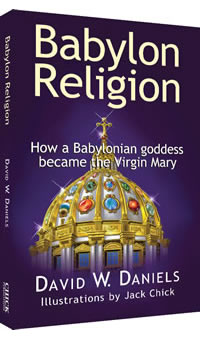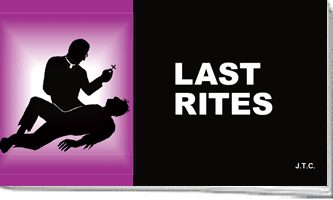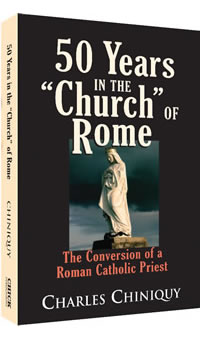Catholic Priestcraft Rooted in Babylonian Idolatry
One of the striking characteristics of Roman Catholicism is that it contains a complete sacerdotal (priest based) system not supported by Scripture. This system includes worship of a wafer, adoration of a goddess, prayers to and for the dead, infant baptism, confession to a priest, confiscation of God's grace to be dispensed through a system of sacraments, suffering for one's own sins after death in purgatory, a celibate hierarchy topped by an infallible pope who claims to be Christ's vice president on earth, no assurance of salvation, bowing to idols, worship of relics, repetitious prayers, etc.
None of these teachings can be solidly backed by the Bible. Many are expressly forbidden.
So, where did these come from? Were they just thought up along the way by imaginative pastors as the church grew? Or were they possibly part of other worship systems existing previously and along side the expanding church? Over a hundred years ago a brilliant Bible scholar named Alexander Hislop determined to find out. After many years of research in hundreds of volumes, he produced a timeless classic which details the origins of these anti-biblical beliefs.
As he traced their histories, incredibly, all trails led to ancient Babylon. There, in the shadow of the infamous tower of Babel he found their source. Shortly after Noah exited the ark, men quickly forgot God's judgment in the flood and set out to rebuild another culture of rebellion like the one God had destroyed. Refusing to worship the Creator, they set up an elaborate priestcraft system to worship God's creation: the sun, moon and sacred stones and His creatures: snakes, birds, bugs, kings and queens. Hislop documented in amazing detail how the Roman Catholic Madonna is just a modernized Babylonian Semiramis; the wafer worship is extracted from sun worship which was almost universal in the pagan world. The characteristics of wheat flour and round shape are traceable in history to requirements for cakes of an "unbloody sacrifice" to the sun god. Even the IHS imprint, according to Hislop, would have been interpreted by the pagan Egyptian to represent his chief deities, Isis, Horus and Seb.
Part of the pagan ceremony included eating the ceremonial cakes. The early apostate church leaders could not pass up the opportunity to pervert the meaning of the Lord's instructions at the last supper, in order to tighten the bondage of the people to the priesthood. This power mechanism had been fine tuned by the pagan priests for thousands of years. Hislop traces the papal system of sacramental grace obtained by good works and rituals back to a merit system which originated in Babylon under Nimrod and his queen. From there it spread universally as the expanding population carried paganism into each new colony of mankind.
Even baptismal regeneration was an early concept taught in Nimrod's system of rebellion. Hislop cites quotations from early writers describing pagan infant baptismal rites for not only cleansing from sin but exorcising demons. These ceremonies are strikingly similar to Roman Catholic infant baptism.
And so on down the list of anti-biblical papal dogmas, Hyslop's book, The Two Babylons, ties them all in one way or another to Nimrod's Babylonian "mysteries" the fountainhead of all idolatry which spread throughout the world. Roman Catholicism is nothing more than ancient paganism in a space suit, finely programmed to seduce the modern man who prefers to cover his rebellion with ritual, rather than submit to a loving, personal Savior.
- See more articles on related topics:
- Catholicism
- Virgin Mary
- Idolatry
- Catholic Doctrine vs Scripture
Other Articles from May/June 1998:
- Is the NIV preparing the way for 'Another Jesus?'
- Priest Rebuked for Giving Eucharist to Clinton, a non-Catholic
- Why Aren't These Churches Growing?
- Small New York Church Targets Every Home on Staten Island
- Witnessing Teams Target the "Biggest Party in the World'
- Britain Set to Legalize Sodomy With 16-Year-Old Children
- Tara Lapinski's Other Medal
More on Catholicism:
Products of Interest:
-

Babylon Religion
224 pages
Learn how a Babylonian goddess became the Virgin Mary. An easy-to-read history of Catholicism's Babylonian origin. 
Last Rites
When this Catholic dies, he learns that his church couldn't save him.-

50 Years in the Church of Rome
368 pages
This classic work shows how this priest began to question Catholic teachings until he became saved, and led his entire parish to salvation. -

Alberto
32-PAGE, FULL COLOR COMIC BOOK - Alberto Series Part 1 - Here is how Alberto, as a Jesuit, helped destroy churches and ministries. But as he read the Scriptures, he saw that Catholicism couldn’t save.



